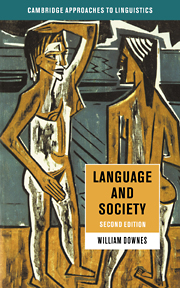Book contents
- Frontmatter
- Contents
- Acknowledgements
- 1 Linguistics and sociolinguistics
- 2 A tapestry in space and time
- 3 Language varieties: processes and problems
- 4 Discovering the structure in variation
- 5 Rhoticity
- 6 At the intersection of social factors
- 7 Change, meaning and acts of identity
- 8 The discourse of social life
- 9 Communication: words and world
- 10 Action and critique
- 11 Language and social explanation
- Further reading
- References
- Index
8 - The discourse of social life
Published online by Cambridge University Press: 05 June 2012
- Frontmatter
- Contents
- Acknowledgements
- 1 Linguistics and sociolinguistics
- 2 A tapestry in space and time
- 3 Language varieties: processes and problems
- 4 Discovering the structure in variation
- 5 Rhoticity
- 6 At the intersection of social factors
- 7 Change, meaning and acts of identity
- 8 The discourse of social life
- 9 Communication: words and world
- 10 Action and critique
- 11 Language and social explanation
- Further reading
- References
- Index
Summary
Here the term ‘language-game’ is meant to bring into prominence the fact that the speaking of language is part of an activity, or a form of life.
Wittgenstein (1953)In this chapter we switch gears and leave higher level sociolinguistic patterns. For the next few chapters, we are going to examine how speakers and hearers use language in the context of everyday discourses. At the end of the book, we will circle around and connect these two kinds of study.
One of the first points to make is that an utterance, in the traditional sense of someone speaking, is something people do. Arguably, the most basic instance of ‘doing’ with language is in face to face context. Lyons (1977) terms this the canonical situation of utterance and describes it as ‘one-one, or one-many, signalling in the phonic medium along the vocal-auditory channel, with all the participants present in the same actual situation able to see one another and to perceive the associated non-vocal paralinguistic features of their utterances, and each assuming the role of sender and receiver in turn’ (Lyons, 1977: 637). Although this is just one type of context of situation for language use (see below), there is evidence from the very form of language that it is perhaps basic in that language evolved within it. It is also the home of such terms as conversation, dialogue and utterance.
We'll begin this chapter by examining some features of utterances in this conversational context.
- Type
- Chapter
- Information
- Language and Society , pp. 275 - 322Publisher: Cambridge University PressPrint publication year: 1998



